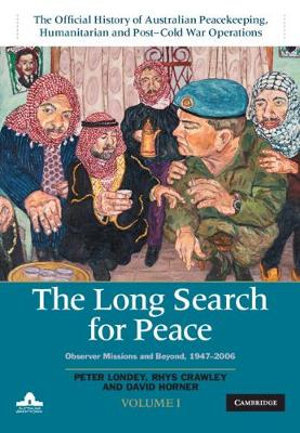Despite being Volume 1 in this series, the other five volumes have preceded this one.

Hardcover 926pp RRP $179.00
It examines Australia’s first peacekeeping missions that were commenced in the period1947 to 1982, and then following them to 2006.
With the newly-formed United Nations advocating decolonization for small nations, there was no shortage of disharmony occurring while this was undertaken under the cloud of the Cold War.
Australia has been involved in all major decolonization efforts with mission durations varied in duration and success – more than 60 years in the Middle East, 53 years in Cyprus, 35 years in Kashmir, with shorter deployments in Rhodesia, Indonesia Uganda and West New Guinea to name a few.
This huge tome is divided into three Parts:
Part 1 – Fifteen chapters on the early Cold War Years: Indonesia, Korea, Kashmir, Palestine and the Middle East, the Congo, West New Guinea and Cyprus;
Part 2 – Thirteen chapters on the later Cold War Years: Peacekeeping after the Vietnam War in Namibia, Rhodesia/Zimbabwe, Kashmir, Cyprus, the Golan Heights, Lebanon, Sinai, and Uganda.
Part 3 – Five chapters on the post-Cold War Years: Cyprus, Israel, Lebanon and the Sinai.
With no definition of ‘peacekeeping’, as no one-size-fits-all, peacekeeping contingents strove to keep disharmony to a minimum while trying to ensure the best outcome for the peoples involved. Peacekeepers frequently established what worked for them in the situation they found themselves in. The inclusion of personal experiences, successes and failures have personalised the operations presented. The maneuvering of the UN, the Australian ministers, the Department of Foreign Affairs and Trade, the Australian Defence Force and the Australian Federal Police are all closely examined and are comprehensively referenced in footnotes.
The Contents contain a detailed breakdown of each chapter and is followed by a list of the 27 maps included. Many of the maps and 100-plus photographs are in colour. Appendix A provides Australian participants for each mission for the period 1947 – 2007: stating place, year of commencement, average number on the ground and the total involved. The other two appendices are Major Office Bearers and UN Humanitarian Mission in Indo-China, 1975 as it did not meet Volume VI’s criteria. The Bibliography and Index are 23 and 26 pages in length respectively.
This expensive production has been beautifully presented. It is a most enlightening, thorough and well-written history on the work done by our (normally) unarmed men and women in frequently highly charged and dangerous environments.
Reviewed for RUSIV by Neville Taylor, February 2020
Contact Royal United Services Institute about this article.






